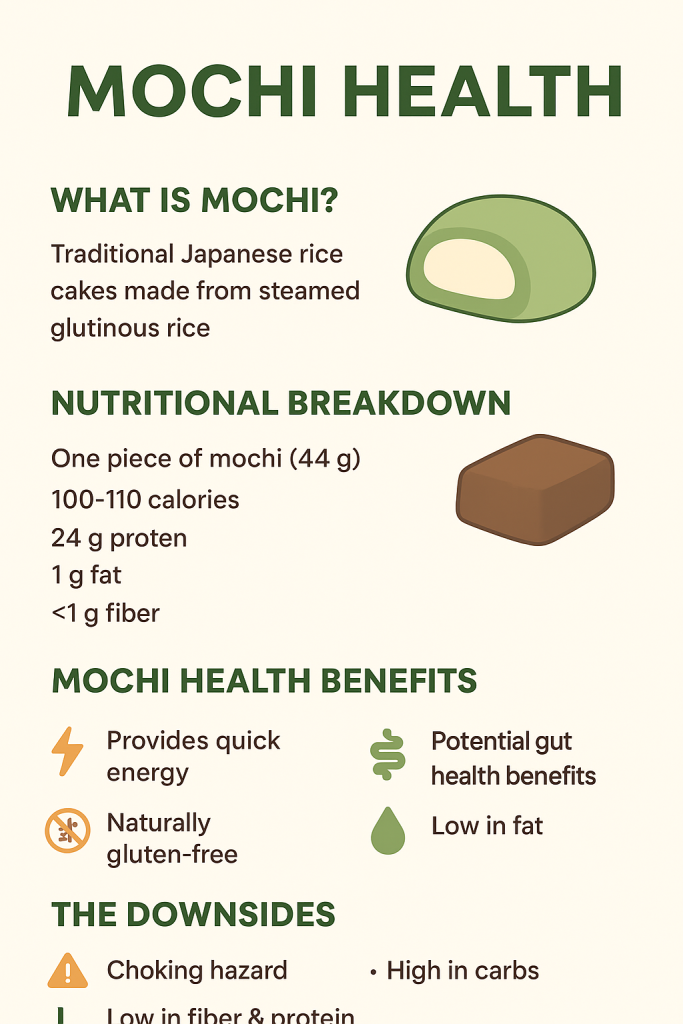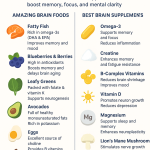What Is Mochi?
Mochi is a traditional Japanese food made by pounding steamed glutinous rice (also called sticky rice) until it becomes a stretchy, chewy dough. It can be eaten plain, wrapped around fillings like red bean paste, or used as a base for ice cream.
- Cultural significance: Mochi is often enjoyed during Japanese New Year celebrations as a symbol of prosperity and good fortune.
- Global popularity: From trendy mochi ice cream in the U.S. to savory mochi soups in Japan, this little rice cake has gone international.
Nutritional Breakdown of Mochi
Is mochi healthy? Let’s look at the numbers.
Calories and Macronutrients
A plain piece of mochi (about 44 grams) typically contains:
- Calories: 100–110
- Carbohydrates: 24g
- Protein: 1g
- Fat: 0g
- Fiber: <1g
(Source: USDA Food Database)
Mochi is mainly carbohydrate-rich, making it a quick energy source. This is why it’s historically popular among farmers and workers needing sustained energy.
Vitamins and Minerals
While plain mochi is not a significant source of vitamins, variations with fillings (like red bean paste or sesame) add:
- Iron
- Magnesium
- Potassium
- Antioxidants (from beans or seeds)
Mochi Health Benefits Backed by Research
Provides Quick Energy
Because of its high carb content, mochi is a great energy booster. A study in the Journal of Nutritional Science and Vitaminology (2018) found that glutinous rice provides sustained energy release compared to other rice varieties, making it useful for athletes and active individuals.
Naturally Gluten-Free
Mochi is made from glutinous rice, but don’t be fooled by the name—it’s naturally gluten-free. Research published in Celiac Disease Journal (2020) confirms rice-based products like mochi are safe alternatives for gluten-sensitive individuals.
Potential Gut Health Benefits
When mochi is filled with fiber-rich ingredients like red bean paste (adzuki beans), it supports digestive health. A study in Nutrients (2019) highlighted adzuki beans as a functional food with prebiotic benefits, helping gut microbiota thrive.
Low in Fat
Compared to other desserts, plain mochi has virtually no fat. This makes it a lighter treat compared to cakes, cookies, or pastries.
The Downsides of Mochi Health
Of course, no food is perfect. While mochi has benefits, there are some things to consider:
- Choking hazard: Mochi’s sticky texture can be dangerous if eaten too quickly. Japan records seasonal hospitalizations during New Year celebrations due to choking incidents.
- Low in fiber & protein: Plain mochi lacks balance compared to whole grains.
- High in carbs: For those managing blood sugar or on a low-carb diet, moderation is key.
How to Enjoy Mochi in a Healthy Way
Portion Control Matters
Stick to 1–2 pieces per serving to avoid excessive calorie spikes.
Choose Healthier Fillings
Opt for:
- Red bean paste (adds protein + fiber)
- Black sesame (rich in healthy fats and minerals)
- Matcha (antioxidants)
Pair It with Protein or Fiber
Pair mochi with tea, fruit, or a protein source to balance your blood sugar and increase satiety.
Mochi Health vs. Other Snacks
Compared to typical desserts:
- Mochi vs. Cake: Mochi has fewer fats but more carbs.
- Mochi vs. Ice Cream: Mochi ice cream is portion-controlled but contains added sugar.
- Mochi vs. Energy Bars: Similar carbs, but energy bars usually pack more fiber and protein.
In short, mochi is a lighter indulgence but should complement, not replace, nutrient-dense snacks.
The Final Word on Mochi Health
Mochi is more than just a chewy rice cake—it’s a cultural symbol, an energy booster, and a guilt-friendly treat when enjoyed in moderation. While it’s high in carbs and low in fiber, choosing variations with beans, seeds, or matcha can elevate its nutritional value.
If you love mochi, there’s no need to feel guilty. Just remember: balance is everything in a healthy lifestyle.
Complementary Wellness Tip
Pairing mochi with intermittent fasting strategies—like the 16/8 fasting method once a week—can help balance energy intake and stabilize blood sugar. For a science-backed explanation of how this fasting approach works, check out the post on “Benefits of 16/8 Fasting Once a Week”. This internal link helps readers explore another health-boosting habit while improving site navigation:



